Effects of Vacuum and Modified Atmosphere Packaging on the Quality and Shelf-Life of Gray Triggerfish (Balistes capriscus) Fillets
Abstract
1. Introduction
2. Materials and Methods
2.1. Materials
2.2. Packaging and Storage Conditions
2.3. Physicochemical Analyses
2.4. Microbiological Analyses
2.5. Sensory Analysis
2.6. Experimental Design and Statistical Analysis
3. Results and Discussion
3.1. Physicochemical Parameters
3.2. Microbiological Parameters
3.3. Sensory Analysis
3.4. Shelf-Life Prediction
4. Conclusions
Author Contributions
Funding
Data Availability Statement
Acknowledgments
Conflicts of Interest
References
- Carlucci, D.; Nocella, G.; De Devitiis, B.; Viscecchia, R.; Bimbo, F.; Nardone, G.; De Devitiis, B.; Viscecchia, R.; Bimbo, F.; Nardone, G. Consumer purchasing behaviour towards fish and seafood products. Patterns and insights from a sample of international studies. Appetite 2015, 84, 212–227. [Google Scholar] [CrossRef] [PubMed]
- Vanhonacker, F.; Pieniak, Z.; Verbeke, W. European consumer perceptions and barriers for fresh, frozen, preserved and ready-meal fish products. Br. Food J. 2013, 115, 508–525. [Google Scholar] [CrossRef]
- Verbeke, W.; Sioen, I.; Pieniak, Z.; Van Camp, J.; De Henauw, S. Consumer perception versus scientific evidence about health benefits and safety risks from fish consumption. Public Health Nutr. 2005, 8, 422–429. [Google Scholar] [CrossRef] [PubMed]
- Fishbase Balistes Capriscus Gmelin. Grey Triggerfish. 1789. Available online: https://www.fishbase.se/summary/Balistes-capriscus.html (accessed on 26 November 2020).
- Runde, B.J.; Rudershausen, P.J.; Sauls, B.; Mikles, C.S.; Buckel, J.A. Low discard survival of gray triggerfish in the southeastern US hook-and-line fishery. Fish. Res. 2019, 219, 105313. [Google Scholar] [CrossRef]
- De Souza, M.R.; Ávila-da-Silva, A.O. Assessment of a multi-fleet fishery for gray triggerfish (Balistes capriscus) in São Paulo State. Acta Sci. Biol. Sci. 2010, 32, 1–7. [Google Scholar]
- Ataliba, C.C.; de Castro, P.M.G.; Carneiro, M.H. Desembarques do peixe-porco Balistes capriscus capturado pela frota industrial do Sudeste e Sul do Brasil, com ênfase ao estado de São Paulo. Bol. Do Inst. Pesca 2009, 35, 247–258. [Google Scholar]
- Aggrey-Fynn, J. Distribution and growth of grey triggerfish, Balistes capriscus (Family: Balistidae), in Western Gulf of Guinea. West. Afr. J. Appl. Ecol. 2009, 15, 49421. [Google Scholar] [CrossRef][Green Version]
- Esteves, E.; Diler, A.; Genç, I.Y. General introduction to seafood quality and safety maintenance and applications. In Handbook of Seafood: Quality and Safety Maintenance and Applications; Genç, I.Y., Esteves, E., Diler, A., Eds.; Nova Science Publishers Inc.: New York, NY, USA, 2016; pp. 1–11. [Google Scholar]
- Dordevic, D.; Buchtova, H. Freshness indicators of defrosted fillets of lepidocybium flavobrunneum in vacuum skin packaging/VSP packaging during cold storage. Acta Aliment. 2016, 45, 338–346. [Google Scholar] [CrossRef]
- Bastos, A.L.; Baish, A.L.M.; Clementin, R.M.; de Souza-Soares, L.A.; Badiale-Furlong, E. Perfil de ácidos graxos da pele e músculo de Balistes capriscus e Menticirrhus litoralis, pescados na região sul do Brasil. Rev. Inst. Adolfo Lutz 2006, 65, 94–99. [Google Scholar]
- Pacheco-Aguilar, R.; Ocaño-Higuera, V.M.; Castillo-Yañez, F.J.; Morán-Palacio, E.F.; Márquez-Ríos, E.; Lugo-Sánchez, M.E. Changes in postmortem quality indices in finescale triggerfish muscle stored in ice. J. Food Biochem. 2003, 27, 333–352. [Google Scholar] [CrossRef]
- Genç, I.Y.; Esteves, E.; Aníbal, J.; Diler, A. Effects of chilled storage on quality of vacuum packed meagre fillets. J. Food Eng. 2013, 115, 486–494. [Google Scholar] [CrossRef]
- Gökoglu, N.; Yerlikaya, P. Seafood Chilling, Refrigeration and Freezing; Wiley-Blackwell: Chichester, UK, 2015. [Google Scholar]
- Huss, H.H.; Reilly, A.; Embarek, P.K.B. Prevention and control of hazards in seafood. Food Control 2000, 11, 149–156. [Google Scholar] [CrossRef]
- Poli, B.M.; Parisi, G.; Zampacavallo, G.; Iurzan, F.; Mecatti, M.; Lupi, P.; Bonelli, A. Preliminary results on quality and quality changes in reared meagre (Argyrosomus regius): Body and fillet traits and freshness changes in refrigerated commercial-size fish. Aquac. Int. 2003, 11, 301–311. [Google Scholar] [CrossRef]
- Gokoglu, N. Innovations in Seafood Packaging Technologies: A Review. Food Rev. Int. 2020, 36, 340–366. [Google Scholar] [CrossRef]
- Bouletis, A.D.; Arvanitoyannis, I.S.; Hadjichristodoulou, C. Application of modified atmosphere packaging on aquacultured fish and fish products: A review. Crit. Rev. Food Sci. Nutr. 2017, 57, 2263–2285. [Google Scholar] [CrossRef] [PubMed]
- Sivertsvik, M.; Rosnes, J.T.; Bergslien, H. Modified atmosphere packaging. In Minimal Processing Technologies in the Food Industry; Ohlsson, T., Bengtsson, N., Eds.; CRC Press Inc./Woodhead Publ. Ltd.: Cambridge, UK, 2002; pp. 61–86. [Google Scholar]
- Sivertsvik, M.; Jeksrud, W.K.; Rosnes, J.T. A review of modified atmosphere packaging of fish and fishery products–significance of microbial growth, activities and safety. Int. J. Food Sci. Technol. 2002, 37, 107–127. [Google Scholar] [CrossRef]
- Stemman, K.; Gerdes, D.; Caporaso, F. Modified Atmosphere Packaging of Seafood. Crit. Rev. Food Sci. Nutr. 1990, 29, 301–331. [Google Scholar] [CrossRef]
- The European Union. Discarding and the Landing Obligation. Available online: https://ec.europa.eu/fisheries/cfp/fishing_rules/discards/ (accessed on 26 November 2020).
- Instituto Português da Qualidade. NP 2930 Produtos da Pesca e da Aquicultura. Determinação do Teor de Azoto Básico Volaátil Total (ABVT) [Fishery and Aquaculture Products. Determination of Total Volatile Basic Nitrogen (TVBN)]; Instituto Português da Qualidade: Lisboa, Portugal, 2009. [Google Scholar]
- The European Union. Commission Regulation (EC) No. 2074/2005 of 5 December 2005. Off. J. Eur. Union 2005, L 338, 27–59. [Google Scholar]
- Szczesniak, A.S. Texture is a sensory property. Food Qual. Prefer. 2002, 13, 215–225. [Google Scholar] [CrossRef]
- Instituto Português da Qualidade. NP 4405 Microbiologia Alimentar; Regras Gerais Para a Contagem de Microrganismos; Contagem de Colónias a 30 °C [Food Microbiology; General Guidance for the Enumeration of Micro-Organisms; Colony Count Technique at 30 °C]; Instituto Português da Qualidade: Lisboa, Portugal, 2002. [Google Scholar]
- International Organization for Standardization. ISO 17410 Microbiology of Food and Animal Feeding Stuffs—Horizontal Method for the Enumeration of Psychrotrophic Microorganisms; International Organization for Standardization: Geneva, Switzerland, 2001. [Google Scholar]
- International Organization for Standardization. ISO 15214 Microbiology of Food and Animal Feeding Stuffs—Horizontal Method for the Emumeration of Mesophilic Lactic Acid Bacteria—Colony-Count Technique at 30 °C.; International Organization for Standardization: Geneva, Switzerland, 1998. [Google Scholar]
- International Organization for Standardization. ISO 15213 Microbiology of Food and Animal Feeding Stuffs—Horizontal Method for the Enumeration of Sulfite-Reducing Bacteria Growing under Anaerobic Conditions; International Organization for Standardization: Geneva, Switzerland, 2003. [Google Scholar]
- Meilgaard, M.C.; Carr, B.T.; Civille, G.V. Sensory Evaluation Techniques, 5th ed.; CRC Press Inc.: Boca Raton, FL, USA, 2016. [Google Scholar]
- Instituto Português da Qualidade. NP EN ISO 8589 Sensory Analysis; General Guidance for the Design of Test Rooms (ISO 8589:2007/Amd 1:2013); Instituto Português da Qualidade: Lisboa, Portugal, 2014. [Google Scholar]
- Fox, J.; Weisberg, S. An R Companion to Applied Regression; SAGE: Thousand Oaks, CA, USA, 2019. [Google Scholar]
- R Core Team. R: A Language and Environment for Statistical Computing; R Foundation for Statistical Computing: Vienna, Austria, 2019. [Google Scholar]
- Cavonius, L.R.; Undeland, I. Glazing herring (Clupea harengus) fillets with herring muscle press juice: Effect on lipid oxidation development during frozen storage. Int. J. Food Sci. Technol. 2017, 52, 1229–1237. [Google Scholar] [CrossRef]
- Duun, A.S.; Rustad, T. Quality of superchilled vacuum packed Atlantic salmon (Salmo salar) fillets stored at −1.4 and −3.6 °C. Food Chem. 2008, 106, 122–131. [Google Scholar] [CrossRef]
- Pathare, P.B.; Opara, U.L.; Al-Said, F.A.J. Colour Measurement and Analysis in Fresh and Processed Foods: A Review. Food Bioprocess Technol. 2013, 6, 36–60. [Google Scholar] [CrossRef]
- Zachary Schuessler Delta E 101. Available online: http://zschuessler.github.io/DeltaE/learn/ (accessed on 6 July 2017).
- ViewSonic Corp. What is Delta E? And Why Is It Important for Color Accuracy? Available online: https://www.viewsonic.com/library/creative-work/what-is-delta-e-and-why-is-it-important-for-color-accuracy/ (accessed on 5 December 2020).
- Howgate, P. Traditional methods. In Fishery Products. Quality, Safety and Authenticity; Rehbein, H., Oehlenschläger, J., Eds.; Blackwell Publishing Ltd.: Oxford, UK, 2009; pp. 19–41. [Google Scholar]
- Huss, H.H. Quality and quality changes in fresh fish. FAO Fish. Tech. Pap. 1995, 348, 1–195. [Google Scholar]
- Massa, A.E.; Palacios, D.L.; Paredi, M.E.; Crupkin, M. Postmortem changes in quality indices of ice-stored flounder (Paralichthys patagonicus). J. Food Biochem. 2005, 29, 570–590. [Google Scholar] [CrossRef]
- Masniyom, P.; Benjakul, S.; Visessanguan, W. Shelf-life extension of refrigerated seabass slices under modified atmosphere packaging. J. Sci. Food Agric. 2002, 82, 873–880. [Google Scholar] [CrossRef]
- Giménez, B.; Roncalés, P.; Beltrán, J.A. Modified atmosphere packaging of filleted rainbow trout. J. Sci. Food Agric. 2002, 82, 1154–1159. [Google Scholar] [CrossRef]
- Sáez, M.I.; Martínez, T.F.; Cárdenas, S.; Suárez, M.D. Effects of vacuum and modified atmosphere on textural parameters and structural proteins of cultured meagre (Argyrosomus regius) fillets. Food Sci. Technol. Int. 2015, 21, 467–478. [Google Scholar] [CrossRef]
- The European Union. Commission Regulation (EC) No 1022/2008 of 17 October 2008 amending Regulation (EC) No 2074/2005 as regards the total volatile basic nitrogen (TVB-N) limits. Off. J. Eur. Union 2008, L 277, 18–20. [Google Scholar]
- Zhou, R.; Zheng, Y.; Liu, Y.; Ma, M. Texture and Quality Assessment of Ready-to-eat Farmed Obscure Puffer Fish (Takifugu obscurus) Fillet by Evaluating Bacterial and Myofibrillar Degradation and Biochemical Changes during Refrigerated Storage. J. Aquat. Food Prod. Technol. 2020, 29, 604–615. [Google Scholar] [CrossRef]
- Sun, Y.; Ma, L.; Ma, M.; Zheng, H.; Zhang, X.; Cai, L.; Li, J.; Zhang, Y. Texture characteristics of chilled prepared mandarin fish (Siniperca chuatsi) during storage. Int. J. Food Prop. 2018, 21, 242–254. [Google Scholar] [CrossRef]
- Coppes-Petricorena, Z. Texture Measurements in Fish and Fish Products. Handb. Seaf. Qual. Saf. Health Appl. 2010, 8850, 130–138. [Google Scholar]
- Alasalvar, C.; Taylor, K.D.A.; Öksüz, A.; Garthwaite, T.; Alexis, M.N.; Grigorakis, K. Freshness assessment of cultured sea bream (Sparus aurata) by chemical, physical and sensory methods. Food Chem. 2001, 72, 33–40. [Google Scholar] [CrossRef]
- Alasalvar, C.; Taylor, K.D.A.; Shahidi, F. Comparative quality assessment of cultured and wild sea bream (Sparus aurata) stored in ice. J. Agric. Food Chem. 2002, 50, 2039–2045. [Google Scholar] [CrossRef] [PubMed]
- Yu, D.; Wu, L.; Regenstein, J.M.; Jiang, Q.; Yang, F.; Xu, Y.; Xia, W. Recent advances in quality retention of non-frozen fish and fishery products: A review. Crit. Rev. Food Sci. Nutr. 2020, 60, 1747–1759. [Google Scholar] [CrossRef]
- Kostaki, M.; Giatrakou, V.; Savvaidis, I.N.; Kontominas, M.G. Combined effect of MAP and thyme essential oil on the microbiological, chemical and sensory attributes of organically aquacultured sea bass (Dicentrarchus labrax) fillets. Food Microbiol. 2009, 26, 475–482. [Google Scholar] [CrossRef]
- Özyurt, G.; Kuley, E.; Özkütük, S.; Özogul, F. Sensory, microbiological and chemical assessment of the freshness of red mullet (Mullus barbatus) and goldband goatfish (Upeneus moluccensis) during storage in ice. Food Chem. 2009, 114, 505–510. [Google Scholar] [CrossRef]
- Fuentes-Amaya, L.F.; Munyard, S.; Fernandez-Piquer, J.; Howieson, J. Sensory, Microbiological and Chemical Changes in Vacuum-Packaged Blue Spotted Emperor (Lethrinus sp), Saddletail Snapper (L. malabaricus), Crimson Snapper (L. erythropterus), Barramundi (L. calcarifer) and Atlantic Salmon (S. salar) Fillets at 4 °C. Food Sci. Nutr. 2016, 4, 479–489. [Google Scholar] [CrossRef]
- Tsironi, T.N.; Taoukis, P.S. Current Practice and Innovations in Fish Packaging. J. Aquat. Food Prod. Technol. 2018, 27, 1024–1047. [Google Scholar] [CrossRef]
- Arashisar, Ş.; Hisar, O.; Kaya, M.; Yanik, T. Effects of modified atmosphere and vacuum packaging on microbiological and chemical properties of rainbow trout (Oncorynchus mykiss) fillets. Int. J. Food Microbiol. 2004, 97, 209–214. [Google Scholar] [CrossRef]
- Cyprian, O.; Lauzon, H.L.; Jóhannsson, R.; Sveinsdóttir, K.; Arason, S.; Martinsdóttir, E. Shelf life of air and modified atmosphere-packaged fresh tilapia (Oreochromis niloticus) fillets stored under chilled and superchilled conditions. Food Sci. Nutr. 2013, 1, 130–140. [Google Scholar] [CrossRef]
- ICMSF. Microorganisms in Foods 2. Sampling for Microbiological Analysis: Principles and Specific Applications, 2nd ed.; Blackwell Scientific Publications; University of Toronto Press: Toronto, ON, Canada, 1986. [Google Scholar]
- Noseda, B.; Vermeulen, A.; Ragaert, P.; Devlieghere, F. Packaging of Fish and Fishery Products. In Seafood Processing: Technology, Quality and Safety; Boziaris, I.S., Ed.; John Wiley & Sons, Ltd.: Chichester, UK, 2014; pp. 237–261. [Google Scholar]
- Gram, L.; Dalgaard, P. Fish spoilage bacteria–problems and solutions. Curr. Opin. Biotechnol. 2002, 13, 262–266. [Google Scholar] [CrossRef]
- Venugopal, V. Seafood Processing: Adding Value Through Quick Freezing, Retortable Packaging and Cook-Chilling; CRC Press: Boca Raton, FL, USA, 2005. [Google Scholar]
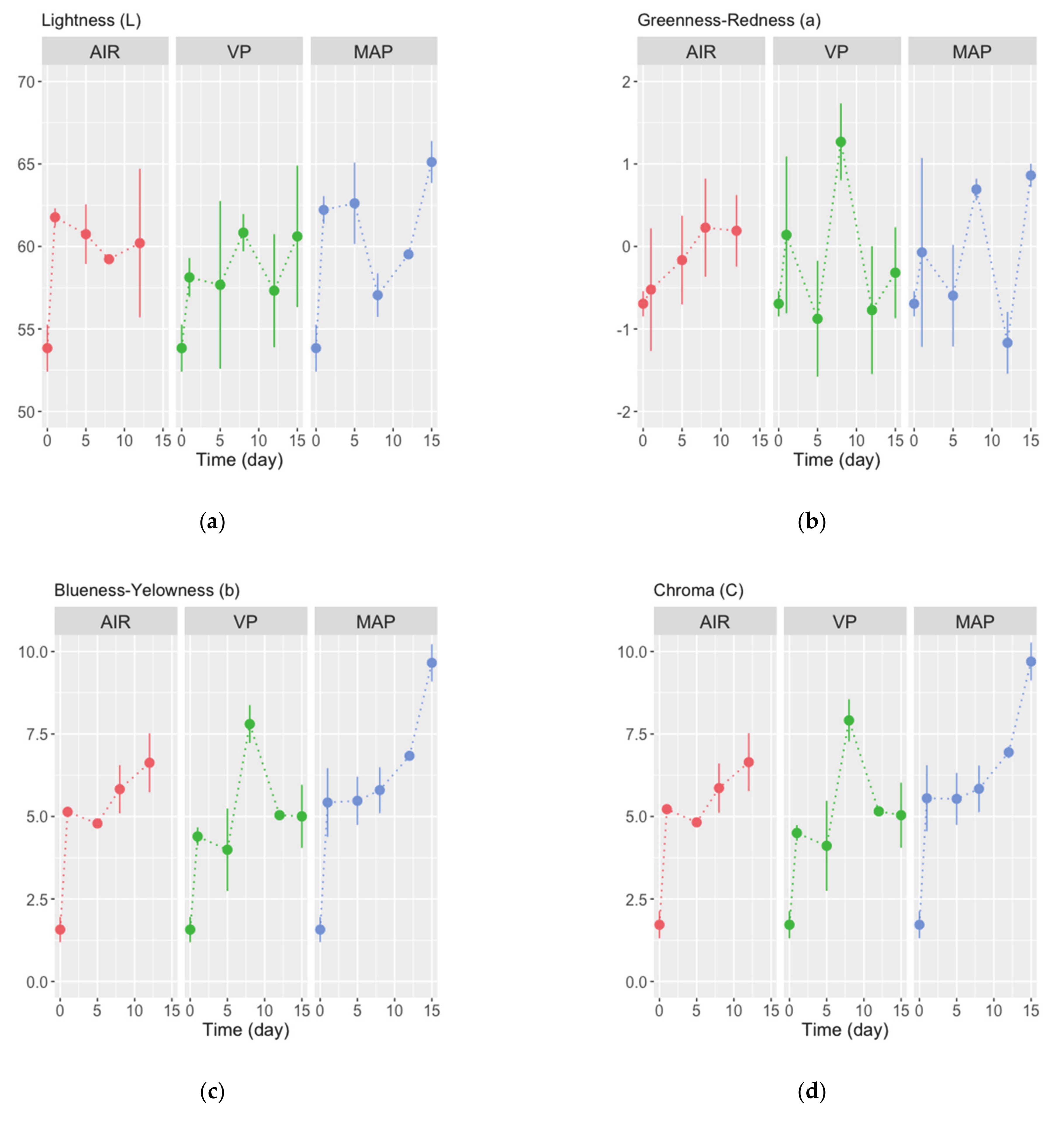
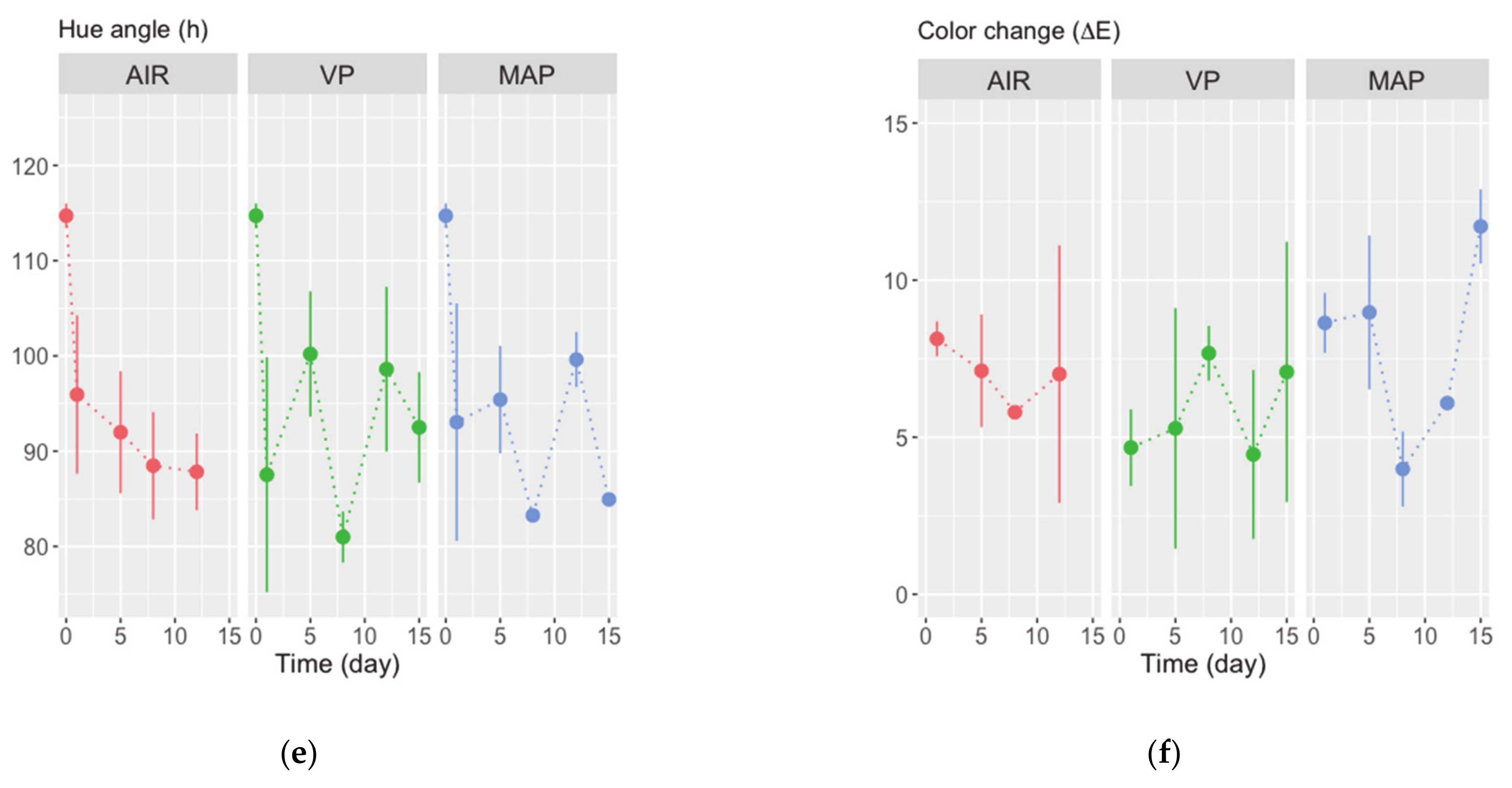
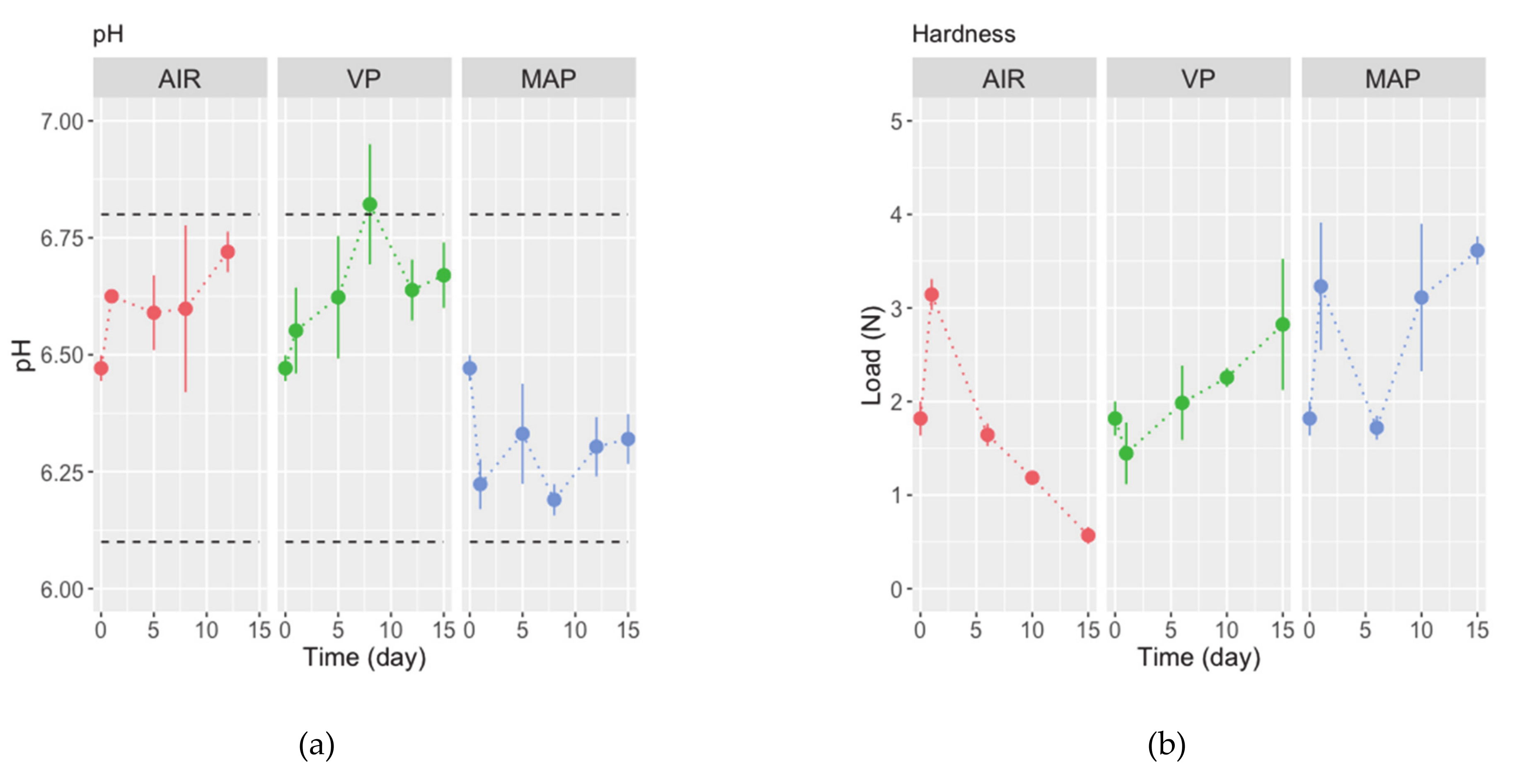
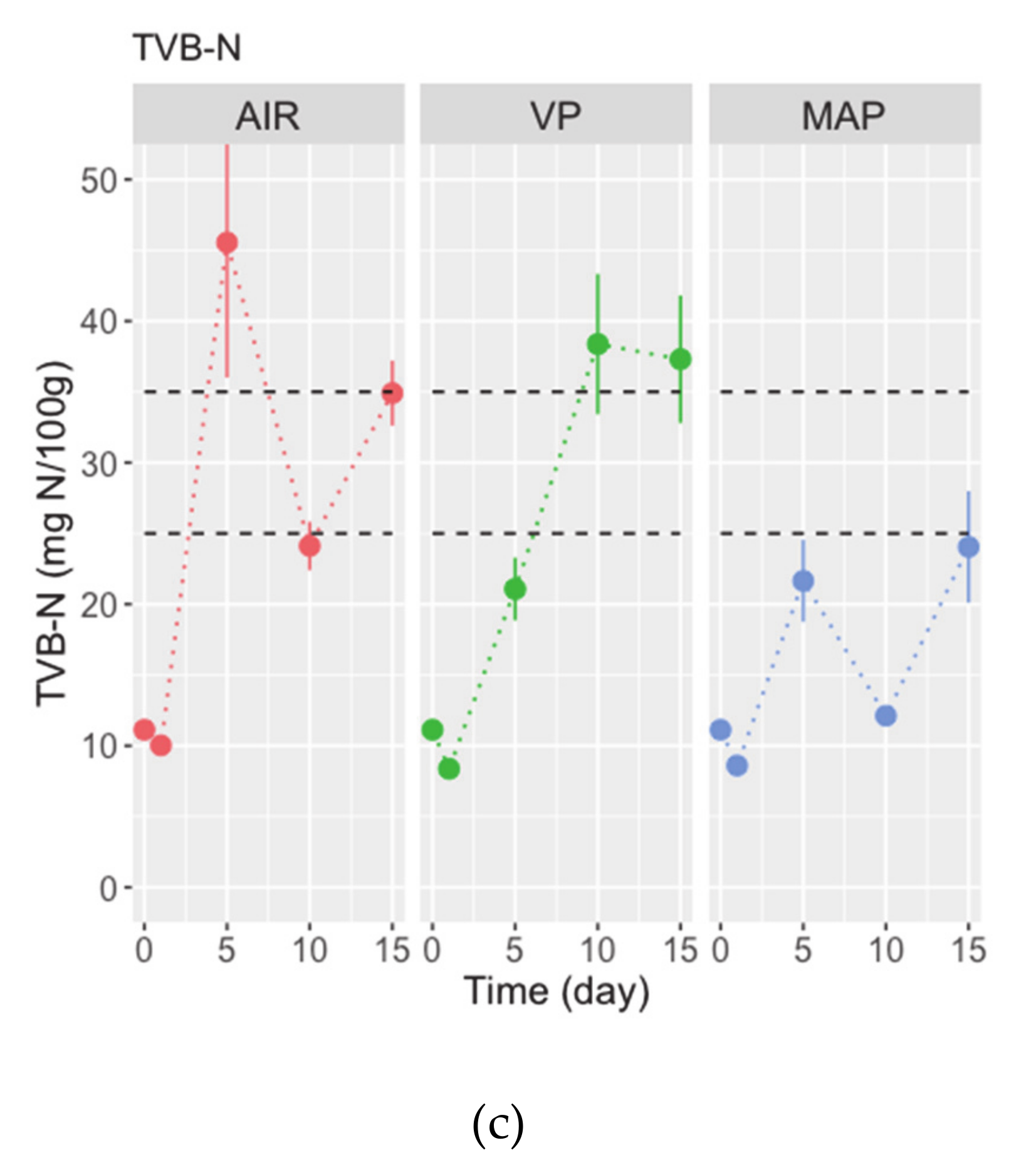
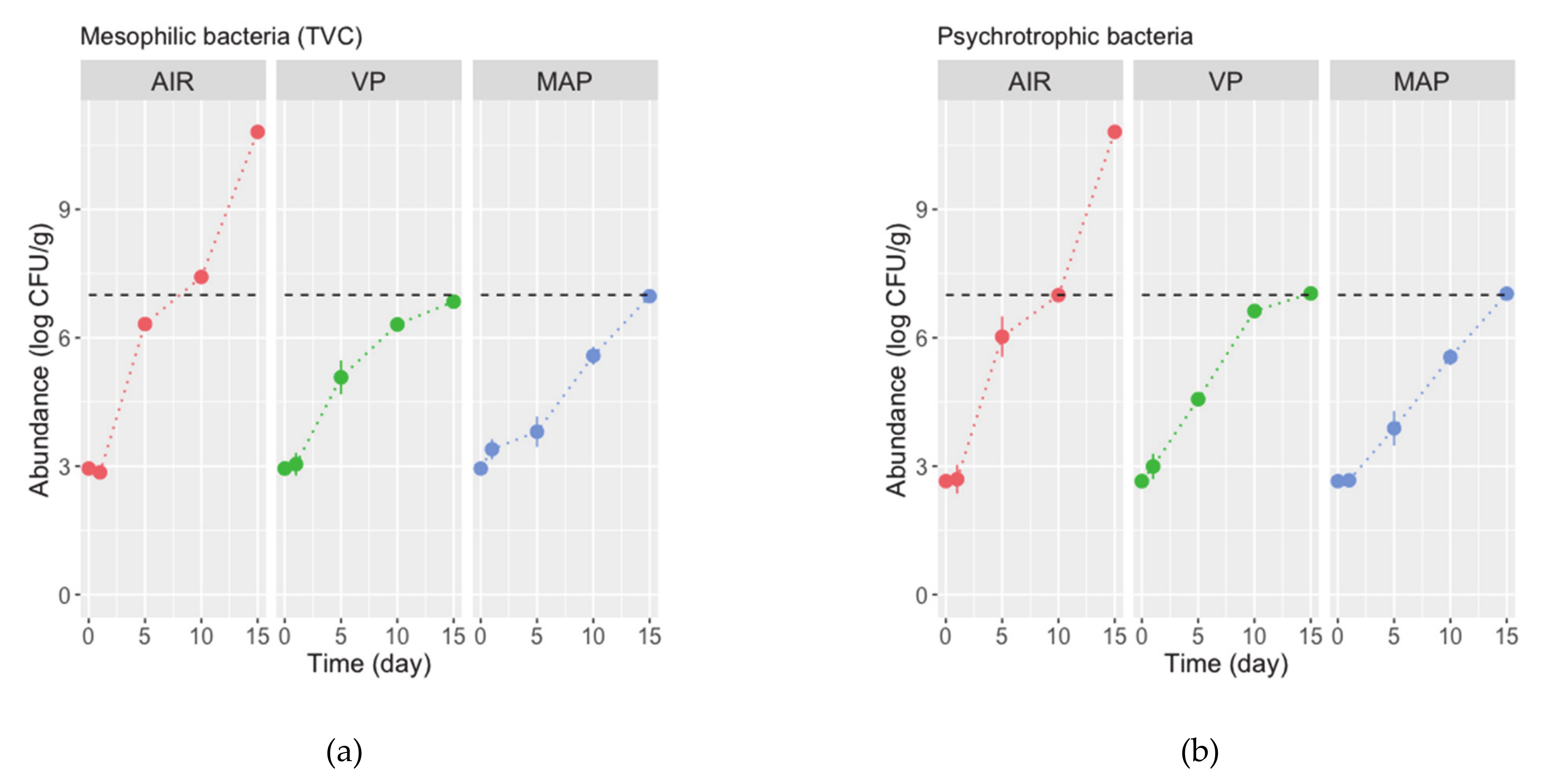
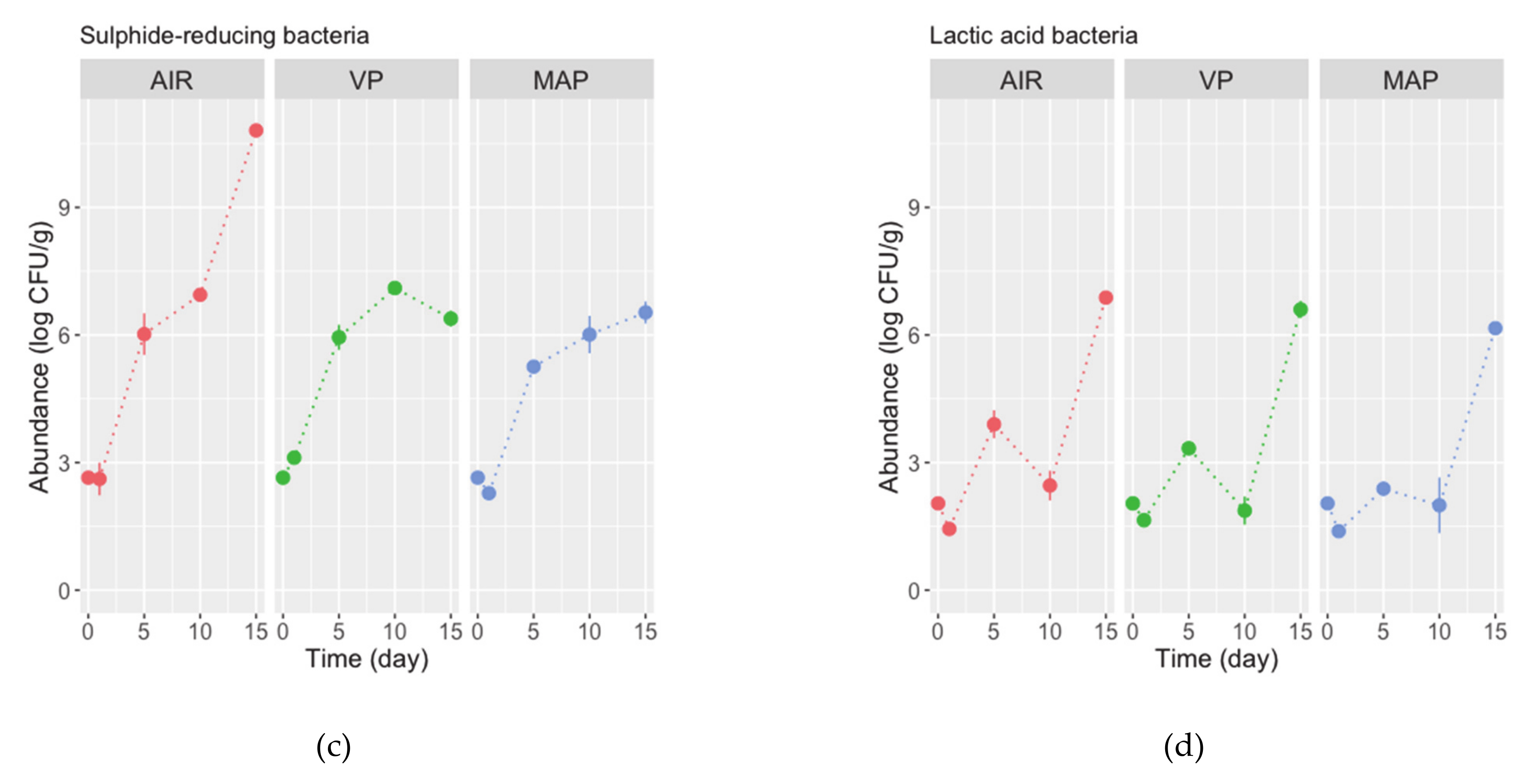
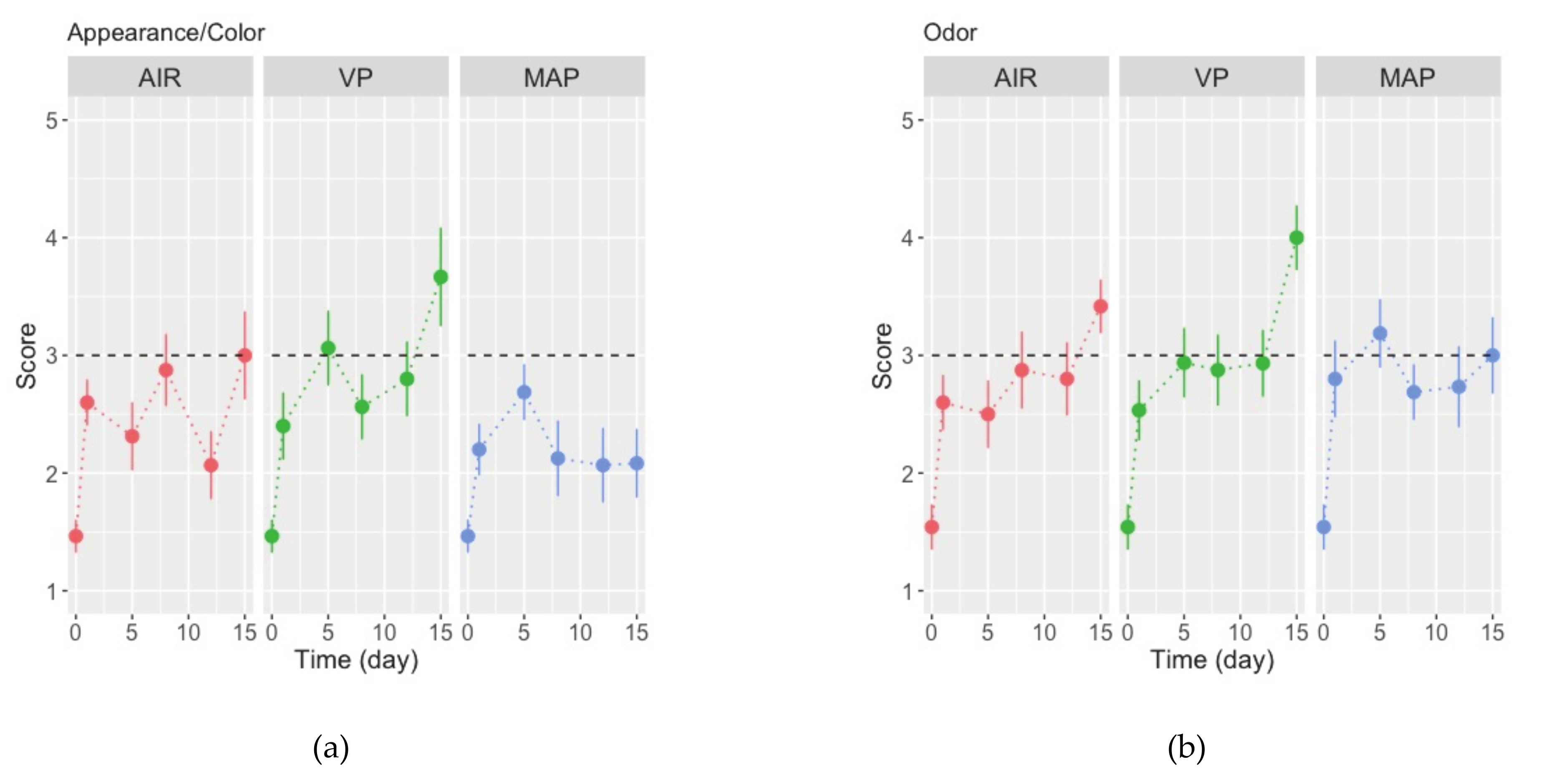
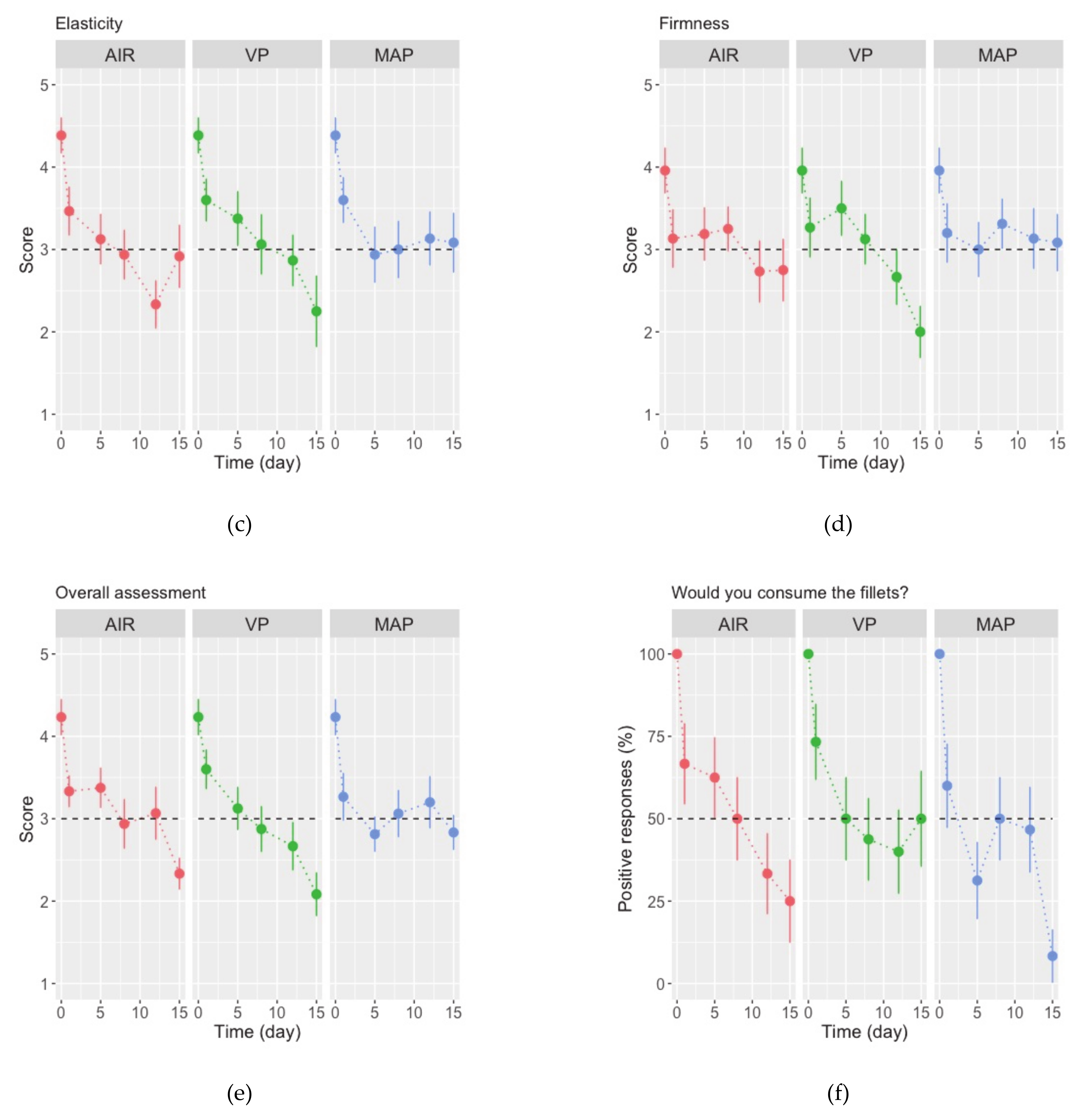
| Parameter | Description per Score | ||||
|---|---|---|---|---|---|
| 1 | 2 | 3 | 4 | 5 | |
| Appearance/Color | Translucent, shiny, sui generis, pink | Slightly translucent and shiny, slightly pink | No color | Dull, dimmed | Very dull, matte, yellowish, without shine |
| Odor | Fresh seaweed | Slightly fresh odor | Neutral, little odor | Spoiled fish | Putrid, ammoniacal |
| Elasticity 1 | Not elastic | Very elastic | |||
| Firmness 2 | Not firm, soft | Very firm, hard | |||
| Overall assessment | Very bad | Bad | Reasonable | Good | Very good |
| Parameter | Factors | F | p-Value |
|---|---|---|---|
| L* | Time Packaging Time × Packaging | 9.77 0.63 0.09 | 0.0036 0.5364 0.9135 |
| a* | Time Packaging Time × Packaging | 10.30 0.02 1.08 | 0.0029 0.9731 0.3497 |
| b* | Time Packaging Time × Packaging | 42.36 1.82 1.65 | <0.0001 0.1770 0.2066 |
| C | Time Packaging Time × Packaging | 40.98 1.81 1.63 | <0.0001 0.1789 0.2100 |
| h* | Time Packaging Time × Packaging | 29.90 0.51 0.81 | <0.0001 0.8450 0.6720 |
| ΔE | Time Packaging Time × Packaging | 0.01 1.178 0.23 | 0.9045 0.3294 0.7970 |
| pH | Time Packaging Time × Packaging | 1.67 17.47 5.11 | 0.2039 <0.0001 0.0108 |
| Hardness | Time Packaging Time × Packaging | 12.11 47.56 14.66 | <0.0001 <0.0001 <0.0001 |
| TVB-N | Time Packaging Time × Packaging | 61.51 0.01 6.91 | <0.0001 0.9874 0.0007 |
| Parameter | Factors | F | p-Value |
|---|---|---|---|
| TVC | Time Packaging Time × Packaging | 37,026 140.3 247.9 | <0.0001 <0.0001 <0.0001 |
| Psychrotrophic bacteria | Time Packaging Time × Packaging | 9586 9177 101.4 | <0.0001 <0.0001 <0.0001 |
| Sulphide-reducing bacteria | Time Packaging Time × Packaging | 38,858 3.37 57.23 | <0.0001 0.0619 <0.0001 |
| Lactic-acid bacteria | Time Packaging Time × Packaging | 1351 1.67 4.25 | <0.0001 0.2209 0.0077 |
| Parameter | Factors | F | p-Value |
|---|---|---|---|
| Appearance/Color | Time Packaging Time x Packaging | 9.13 5.64 1.64 | <0.0001 0.0040 0.0959 |
| Odor | Time Packaging Time x Packaging | 13.63 0.63 0.67 | <0.0001 0.5351 0.6125 |
| Elasticity | Time Packaging Time x Packaging | 10.98 0.38 0.72 | <0.0001 0.6822 0.7063 |
| Firmness | Time Packaging Time x Packaging | 5.51 0.50 0.69 | <0.0001 0.6047 0.7372 |
| Overall assessment | Time Packaging Time x Packaging | 15.66 0.47 0.88 | <0.0001 0.6281 0.5525 |
Publisher’s Note: MDPI stays neutral with regard to jurisdictional claims in published maps and institutional affiliations. |
© 2021 by the authors. Licensee MDPI, Basel, Switzerland. This article is an open access article distributed under the terms and conditions of the Creative Commons Attribution (CC BY) license (http://creativecommons.org/licenses/by/4.0/).
Share and Cite
Esteves, E.; Guerra, L.; Aníbal, J. Effects of Vacuum and Modified Atmosphere Packaging on the Quality and Shelf-Life of Gray Triggerfish (Balistes capriscus) Fillets. Foods 2021, 10, 250. https://doi.org/10.3390/foods10020250
Esteves E, Guerra L, Aníbal J. Effects of Vacuum and Modified Atmosphere Packaging on the Quality and Shelf-Life of Gray Triggerfish (Balistes capriscus) Fillets. Foods. 2021; 10(2):250. https://doi.org/10.3390/foods10020250
Chicago/Turabian StyleEsteves, Eduardo, Luís Guerra, and Jaime Aníbal. 2021. "Effects of Vacuum and Modified Atmosphere Packaging on the Quality and Shelf-Life of Gray Triggerfish (Balistes capriscus) Fillets" Foods 10, no. 2: 250. https://doi.org/10.3390/foods10020250
APA StyleEsteves, E., Guerra, L., & Aníbal, J. (2021). Effects of Vacuum and Modified Atmosphere Packaging on the Quality and Shelf-Life of Gray Triggerfish (Balistes capriscus) Fillets. Foods, 10(2), 250. https://doi.org/10.3390/foods10020250







